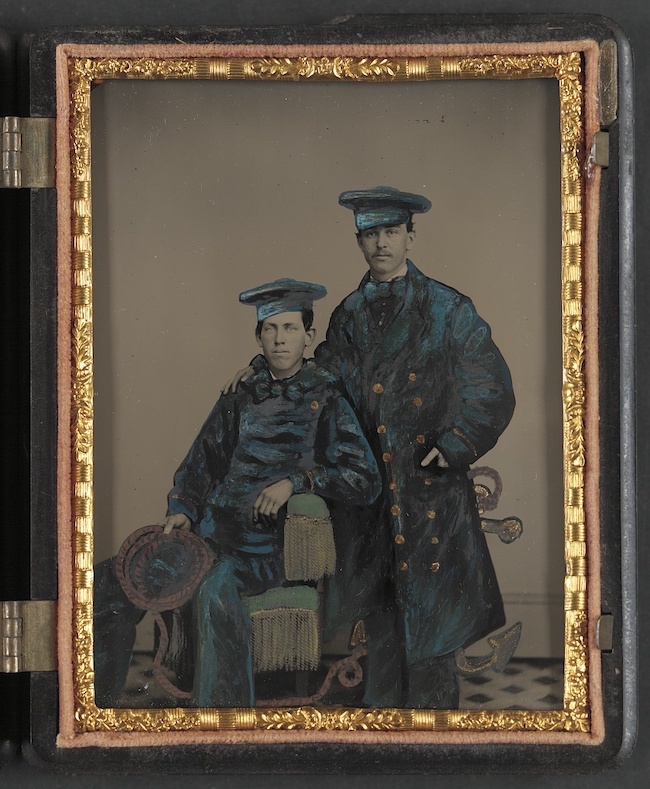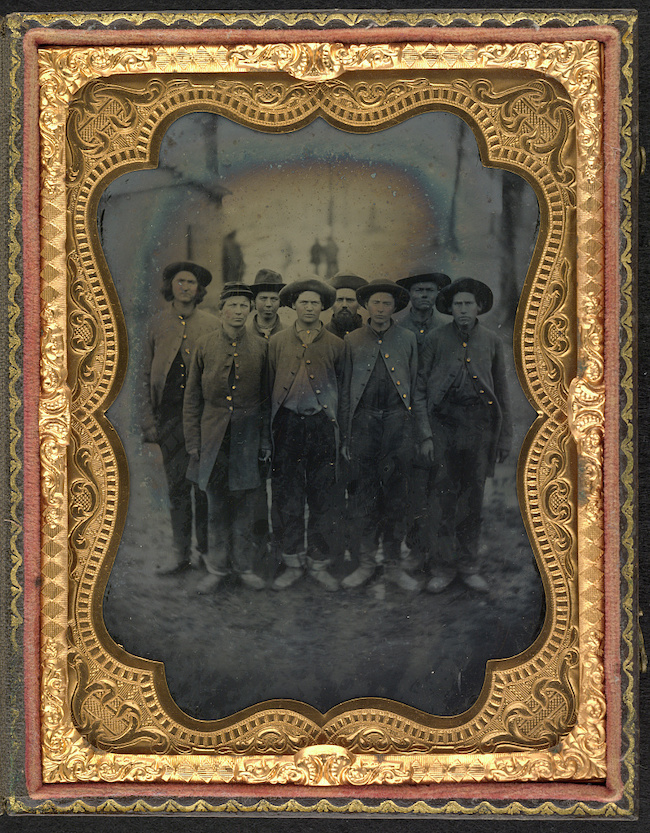From the decks of great sailing vessels to the smoky grog shops of Manhattan, sailors of the American Civil War era filled the air with songs and stories. They sung of love, war, and sex, they boasted of their exploits, and they spun elaborate yarns. But if there was one subject reserved for more hushed tones–when mentioned at all–it was that of sexual intimacy between the sailors themselves. The journals of Philip C. Van Buskirk, a Marine Corps musician who served aboard multiple U.S. Navy vessels in the 1850s, reveal a world in which clandestine relations between seamen were not at all uncommon. In fact, they were often not even all clandestine. Van Buskirk confessed that “though I have met with many; I have met with but one good-looking boy in the Service” who did not engage in some form of sexual intercourse with his fellow seamen.
Common as such encounters may have been, they still involved violations of Navy regulations against “sodomy” and could result in prosecution if sailors were caught in the act and reported by their officers or even fellow seamen. The resulting Courts Martial records can consequently provide intimate looks into this obscure aspect of sailors’ lives. One series of records in particular reveals a tragic tryst between a former Confederate soldier named Marion Chapman and a young English immigrant named Henry Harper.

Marion Edward Chapman (or Chatman) was a tenant farmer who lived in Henry County, Tennessee prior to the Civil War. He married Mary J. Bruce in 1859 when he was just sixteen years old. The young couple owned no real estate and only $50 worth of personal property. They had one child together, a boy born in 1861. Later in the same year, at the age of eighteen, Marion Chapman enlisted in the 46th Tennessee Infantry, C.S.A. Described as a “good soldier” by a comrade who remembered him affectionately as “Ed,” Chapman served in General Gideon Pillow’s division and the Confederate Army of the Tennessee until he was wounded at the Battle of Stones River in January 1863. After recovering from his injury, he served as a nurse at a Confederate hospital before returning to his unit in the fall. He was captured by Union soldiers during their assault on Missionary Ridge on November 25th, 1863 and was sent to the Rock Island Barracks Military Prison in Illinois. At the start of a frigid winter and in the midst of a smallpox epidemic that would kill over 600 fellow prisoners, Chapman opted to become a “Galvanized Yankee,” taking the oath of allegiance and enlisting as a landsman in the Union Navy in January 1864. His enlistment record reveals that he was then 5’7 1/2” tall, with blue eyes, black hair, dark skin, and a “pitted” face. It is possible this scarring could have been the result of a bout of smallpox from his time at Rock Island.
In the summer of 1864, Chapman joined the crew of the U.S.S. Pinola, a Unadilla-class gunboat then serving off the coast of Mobile Bay, Alabama. During Chapman’s time on the Pinola, he was actively engaged in pursuing blockade-runners, capturing two such vessels, and destroying a third. But life on blockade duty involved a great deal of mundane routines and long waits, and with it all came a tremendous sense of isolation and loneliness.
Chapman attained the rank of ship’s cook on the Pinola and developed a close relationship with one particular shipmate, a young landsman named Henry Harper. Harper was an English immigrant who enlisted at the New York Naval Rendezvous in August 1864. His enlistment record indicates he was a substitute, meaning he had been paid by a conscripted man to serve in his stead. At the time of his enlistment, Harper was a nineteen-year-old laborer, described as being 5’3” tall, with blue eyes, light hair, and a light complexion.

On May 3, 1865, Seaman James Williams went to the Pinola’s Master at Arms and accused Chapman and Harper of having engaged in a “connection” of sexual nature in their quarters below deck. The two were soon charged with “scandalous conduct, tending to the destruction of good morals” and tried in separate courts martial the following month, where each of them pleaded “not guilty.” Williams was, unsurprisingly, one of the prosecution’s principal witnesses. “I saw the accused have connection with the boy,” he stated at Chapman’s trial. “I had seen him do the same thing several times, before that night, but did not say anything about it.”
The next witness, Quartermaster Burton Bunker, described in detail a relationship that seemed to extend beyond sexual gratification. In fact, Bunker testified that he never actually saw the two men have any form of intercourse. On multiple different occasions, however, he witnessed Chapman and Harper “rolled up in a blanket, huddled together like man and wife.” He also recounted seeing Chapman “washing Harper, combing his hair, and caressing him.” Chapman evidently kept a watchful and possessive eye on Harper; “the boy did not dare converse with anyone else,” Bunker said, “for fear that [Chapman] would correct him for it.” The quartermaster observed the two lying together late one night and overheard Harper cry out in an exclamation Bunker interpreted as a protest against Chapman’s overbearing nature. “Oh don’t Chapman!” he heard him say. “You hurt me, you smother me!”
Henry Harper’s succinct, yet poignant defense is included verbatim in his court martial record:
I wish to say that I laid with the man every night, but as to anything wrong, I did not do it. He used to watch me every night. I turned in with him ever since I was in the Ship. On the night in question I said to him not to cover my head with the blanket, not to smother me.
The officers presiding over the two sailors’ courts martial were unconvinced by Harper’s account. They found both men guilty of “scandalous conduct” and sentenced them to ten years’ imprisonment.
Amazingly, Mary J. Chapman learned neither of her husband’s career in the U.S. Navy nor its conclusion until 1913. His Confederate comrades told her he fell ill and died in the C.S. service in 1864. It was not until she filed for a widow’s pension that she uncovered what really happened. In December 1865, at the close of a long and bloody war in which he served on both sides, endured the hardships of arduous and bloody campaigns, survived illness and malnutrition, and fought honorably in battles both on land and sea, Marion Edward Chapman died in a Federal military prison. His downfall, in the end, was pursuing a desire forbidden by nineteenth century Anglo-American society. The fate of Henry Harper remains a mystery.
 Brendan Hamilton is an independent researcher, writer, and lifelong student of the American Civil War. He is an associate editor for Irish in the American Civil War, the author of a collection of poetry entitled Jerusalem Plank Road, and is currently working on a nonfiction project about reformatory inmates who served in the American military. He holds an MFA in writing and poetics from Naropa University’s Jack Kerouac School of Disembodied Poetics and a BA in history from the College of William & Mary.
Brendan Hamilton is an independent researcher, writer, and lifelong student of the American Civil War. He is an associate editor for Irish in the American Civil War, the author of a collection of poetry entitled Jerusalem Plank Road, and is currently working on a nonfiction project about reformatory inmates who served in the American military. He holds an MFA in writing and poetics from Naropa University’s Jack Kerouac School of Disembodied Poetics and a BA in history from the College of William & Mary.

NOTCHES: (re)marks on the history of sexuality is licensed under a Creative Commons Attribution-NonCommercial-NoDerivatives 4.0 International License.
Based on a work at www.notchesblog.com.
For permission to publish any NOTCHES post in whole or in part please contact the editors at NotchesBlog@gmail.com




